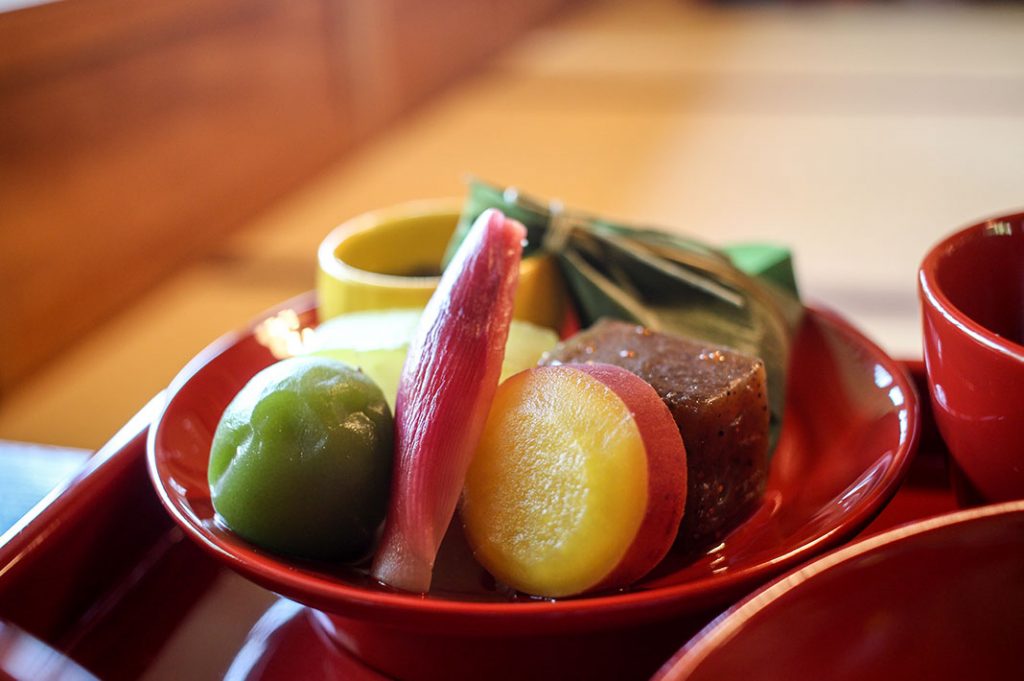Shojin Ryori is the traditional fare of Zen Buddhist monks in Japan. This plant-based dining style, along with Zen Buddhism itself, started making its way around Japan in the 12th century, and is still an integral part of the practice today. Despite shojin ryori being a cuisine for religious devotees, you don’t have to be a monk, or even a vegetarian, to try it. Even an intrepid carnivore will be surprised by the many delicious flavours and textures of this Buddhist vegetarian cuisine.

Why vegetarian?
In Buddhist belief, the principle ‘ahimsa’ prohibits violence against all living beings. Essentially, as we are all spiritually connected, we would harm ourselves by killing another. So, to avoid being harmed three times a day, it became common to avoid the consumption of animals. This way, the spirit would remain clear and primed for the hours of deep meditation every day.
For this reason, shojin ryori is strictly plant-based. Even garlic and onion—quite strong flavours—are omitted as they, too, are thought to cloud the spirit. But, despite the lack of heavy hitter ingredients, shojin ryori is still full of flavour.
The broths are steeped with umami-rich dried mushrooms, kelp and vegetables, which gives them a lovely, savoury taste. And no sauces or broths are too strong, as the intention is to be able to taste the base ingredients rather than mask them.
In terms of ingredients, the ever-versatile tofu appears in its various forms—fresh, fried and yuba (tofu skin). You’ll also likely see konnyaku (a firm, jelly-like block made from a konjac root) and yu (wheat gluten). If you are vegetarian or vegan, it is important to check ahead regarding ingredients, as occasionally things like dried bonito and dairy may be used in part of the meal.
Perhaps the most charming thing about shojin ryori, though, is that it relies on seasonal, local produce. No matter the season, nature will organically provide exactly what our bodies need. In summer, cucumber and tomato can cool you down; in winter, the warm comfort of root vegetables soothes the soul while nourishing the body.
Multiple dishes
One of my favourite things about shojin ryori is that you can try multiple dishes in one sitting. Typically, you’ll get a soup, three sides, rice, pickles and perhaps even dessert. The sides could be anything from small salads to simmered dishes, tempura or roasted miso dengaku (a personal favourite).
It may sound like a mish-mash, but on the contrary, shojin ryori is carefully thought out. First of all, the meal is nutritionally balanced, giving you all the vitamins and minerals to keep you going. There is also a balance of colours, flavours, textures and temperatures across all the dishes, highlighting just how important the concept of balance is in Buddhism.
Mindfully Prepared and Eaten
Shojin ryori roughly translates to ‘devotion food’, the name relating to the quest for enlightenment. In fact, the preparation and consumption of shojin ryori both play an important part in Buddhist practice.
The monks who prepare the food are meant to do so in a calm and mindful manner. Everything is carried out meticulously; this is no hastily whipped together ‘whatever’s in the fridge’ style of cooking. Yet another nice aspect of shojin ryori is that there is very little wastage. For example, the vegetable peels from one dish are used to flavour the soup of another dish. It’s such a sustainable way of cooking.
Eating shojin ryori is an exercise in mindfulness, as well. To pay respect to the bounty of nature and the efforts of the chefs, it should be enjoyed without distraction. Ditch the phone (after you’ve taken a photo, of course!) and savour every bite. Try to guess all the flavours in each dish and appreciate all it took to get to you. This mindful way of eating is certainly not the norm in today’s culture, but perhaps it should be.
Where to find Shojin Ryori
The best place to try shojin ryori is, without question, at a Buddhist Temple. Being surrounded by nature, architecture and devout monks really elevates the whole experience. However, not all temples offer dining experiences to the public, so you’ll need to do some research. In Kyoto, an internet search will reveal a number of great options, including Izusen at Daiji-in Temple and Shigetsu at Tenryuji Temple. Read more about the Michelin quality fare at Shigetsu here.
For those looking to get even closer to the Zen lifestyle, you could consider staying overnight at a Buddhist Temple in “shukubo” lodging. Many of these stays include shojin ryori meals prepared by the monks and delivered to your room. A great place to try this is on the mystical mountain Koyasan in Wakayama prefecture, a few hours from Kyoto and Osaka.
If you’re only in town for a limited time, it is possible to find shojin ryori food in the major cities—it just won’t be prepared by a monk. In Tokyo, Sougo, Bon and Itosho are all good options.
If you’re seeking a memorable experience in Japan, head for a Buddhist Temple that offers shojin ryori. You don’t have to be a Buddhist, a meditation-guru or even a vegetarian to appreciate this delicious Buddhist vegetarian cuisine. Who knows, the experience may inspire you to cook and eat more mindfully in future. At the very least, it’s bound to be a delicious meal you won’t soon forget.
Post by Japan Journeys.